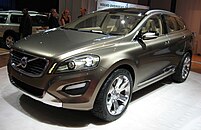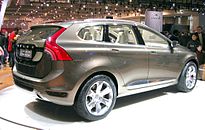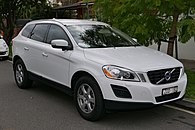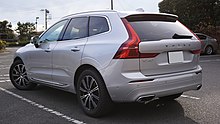The Volvo XC60 is a compact luxury crossover SUV manufactured and marketed by Swedish automaker Volvo Cars since 2008.
| Volvo XC60 | |
|---|---|
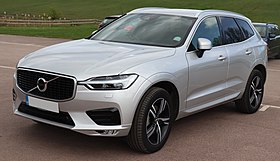 2018 Volvo XC60 R-Design D5 P-Pulse | |
| Overview | |
| Manufacturer | Volvo Cars |
| Production | 2008–present |
| Body and chassis | |
| Class | Compact luxury crossover SUV |
| Body style | 5-door SUV |
| Layout | |
The XC60 is part of Volvo's 60 Series of automobiles, along with the S60, S60 Cross Country, V60, and V60 Cross Country. The first generation model introduced a new style for the 60 Series models. Along with the rest of the line-up, the first-generation XC60 was refreshed in 2013. Similarly, the second-generation model, released in 2017, is the first in the series.[1] The car was named Car of the Year Japan for 2017–2018.
XC60 concept (2007)
editThe XC60 concept was unveiled at the 2007 Detroit Auto Show.[2] It included a glass roof and a newly styled grille. The model introduced Volvo's new styling cues, which were gradually implemented throughout the model range. The XC60 concept also included a new shifting mechanism, electronic bootlid, and 20-inch wheels.[3]
- Volvo XC60 concept
- Volvo XC60 concept
First generation (2008–2016)
edit| First generation | |
|---|---|
 2013 Volvo XC60 (AU) | |
| Overview | |
| Production |
|
| Model years | 2009[5]–2017 |
| Assembly | |
| Designer | Steve Mattin |
| Body and chassis | |
| Layout | |
| Platform | Volvo P3 platform[7] |
| Related | |
| Powertrain | |
| Engine | |
| Transmission |
|
| Dimensions | |
| Wheelbase | 2,774 mm (109.2 in) |
| Length | 4,644 mm (182.8 in) |
| Width | 1,891 mm (74.4 in) |
| Height | 1,715 mm (67.5 in) |
| Curb weight | 1,809–1,900 kg (3,988–4,189 lb)[8] |
The production vehicle was unveiled at the 2008 Geneva Motor Show.[9] Sales began in Europe in the third quarter of 2008 and in North America in early 2009 as a 2010 model.[10][11] The XC60 has been Volvo's best selling car since 2009.[12]
Manufactured by subsidiary Volvo Car Gent in Ghent, Belgium, the first generation XC60 is based on Volvo's P3 platform and the XC60 shares technology with the Land Rover Freelander of 2007. At the time of development, both Land Rover and Volvo were owned by Ford and development was split between the two subsidiaries. Much of the engineering and tuning of this CUV was done by Volvo in Sweden, although offroad capabilities were developed at Land Rover in England.
In April 2010, an R-Design variant of the XC60 became available, featuring a colour-matching body kit, stiffer chassis and damping, and other unique exterior/interior trim.
In February 2013, Volvo debuted a refreshed version of the XC60, to be released for the 2014 model year. Exterior updates are primarily cosmetic, with changes to the grille and front driving lights, loss of black cladding along the lower doorsills, and minor changes to the exhaust tips and taillights. Interior updates include new materials and dashboard trims, available paddle shifter on the T6 model, and introduction of a 7" touch-screen display.[13]
- Volvo XC60 pre-facelift (AU)
- Volvo XC60 R-Design pre-facelift (AU)
- Volvo XC60 interior post-facelift
- Volvo XC60 post-facelift (AU)
- Volvo XC60 R-Design post-facelift (UK)
- Volvo XC60 R-Design post-facelift (UK)
XC60 Ocean Race
editIn 2014, special blue colour.[14]
XC60 Plug-in Hybrid Concept
editThe Volvo XC60 plug-in hybrid concept was unveiled at the 2012 North American International Auto Show. The powertrain mated a 270 hp (201 kW; 274 PS) turbocharged 4-cylinder driving the front wheels with a 70 hp (52 kW; 71 PS) electric motor driving the rear wheels, giving the powertrain a peak combined output of 350 hp (261 kW; 355 PS).[15] According to Volvo, the XC60 Plug-in Hybrid has an all-electric range of up to 35 mi (56 km) for a fuel economy equivalent of 105 mpg‑US (2.2 L/100 km; 126 mpg‑imp) and a total range of 600 mi (970 km). Fuel economy when running on the gasoline engine is estimated at 50 mpg‑US (4.7 L/100 km; 60 mpg‑imp). Recharging time is 3.5 hours from a 220 V outlet and 7.5 hours from a 110 V outlet.[16][17] The model was never released for production.
- XC60 Plug-in Hybrid Concept at 2012 NYIAS
Engines
edit| Model | Year(s) | Engine Code | Power at rpm | Torque at rpm | Displacement | Comment | Fuel consumption – combined |
|---|---|---|---|---|---|---|---|
| T6 AWD[18] | 2009–2010 | B6304T2[19] | 285 PS (210 kW; 281 hp) at 5600 | 400 N⋅m (295 lb⋅ft) at 1500–4800 | 2,953 cc (180.2 in3) | Inline 6 with turbocharger | 11.9 L/100 km (20 mpgUS)[20] |
| 2.0T[21] | 2010–2011 | B4204T6 | 203 PS (149 kW; 200 hp) at 6000 | 300 N⋅m (221 lb⋅ft) at 1750–4000 | 1,999 cc (122.0 in3) | Inline 4 with turbocharger | 8.5 L/100 km (28 mpgUS)[22] |
| 2010–2010 | B6324S[23] | 238 PS (175 kW; 235 hp) at 6200 | 320 N⋅m (236 lb⋅ft) at 3200 | 3,192 cc (194.8 in3) | Inline 6 | 11.2 L/100 km (21 mpgUS)[24] |
| 2011–2014 | B6324S5 | 243 PS (179 kW; 240 hp) at 6400 | 320 N⋅m (236 lb⋅ft) at 3200 | 3,192 cc (194.8 in3) | Inline 6 | 9.9 L/100 km (24 mpgUS)[26] |
| T6 AWD[27] | 2011–2015 | B6304T4[28] | 304 PS (224 kW; 300 hp) at 5600 | 440 N⋅m (325 lb⋅ft) at 2100–4200 | 2,953 cc (180.2 in3) | Inline 6 with turbocharger | 10.7 L/100 km (22 mpgUS)[29] |
| T6 AWD R-Design | 2011–2016 | B6304T4[30] | 329 PS (242 kW; 324 hp)[31] at 5600 | 487 N⋅m (359 lb⋅ft) at 2100–4200 | 2,953 cc (180.2 in3) | Inline 6 with turbocharger | 10.7 L/100 km (22 mpgUS)[32] |
| T5[25] | 2012–2013 | B4204T7 | 240 PS (177 kW; 237 hp) at 5500 | 320 N⋅m (236 lb⋅ft) at 1800–5000 | 1,999 cc (122.0 in3) | Inline 4 with turbocharger | 8.5 L/100 km (28 mpgUS)[33] |
| 2014–2017 | B4204T11 | 245 PS (180 kW; 242 hp) at 5500 | 350 N⋅m (258 lb⋅ft) at 1500–4800 | 1,969 cc (120.2 in3) | Inline 4 with turbocharger | 6.7 L/100 km (35 mpgUS)[35] |
| 2014–2017 | B4204T9 | 306 PS (225 kW; 302 hp) at 5700 | 400 N⋅m (295 lb⋅ft) at 2100–4500 | 1,969 cc (120.2 in3) | Inline 4 with turbo and supercharger | 7.0 L/100 km (34 mpgUS) for T6[36] 7.7 L/100 km (31 mpgUS) for T6 AWD[36] |
| T5 AWD[37] | 2015–2016 | B5254T12 | 254 PS (187 kW; 251 hp) at 5500 | 360 N⋅m (266 lb⋅ft) at 1800–4200 | 2,497 cc (152.4 in3) | Inline 5 with turbocharger | 8.9 L/100 km (26 mpgUS)[38] |
| Model | Year(s) | Engine code | Power at rpm | Torque at rpm | Displacement | Comment | Fuel consumption – combined |
|---|---|---|---|---|---|---|---|
| 2009 | D5244T4 | 185 PS (136 kW; 182 hp) at 4000 | 400 N⋅m (295 lb⋅ft) at 2000–2750 | 2,400 cc (146.5 in3) | Inline 5 with turbocharger | 7.5 L/100 km (31 mpgUS)[40] 8.3 L/100 km (28 mpgUS) for Geartronic[41] |
| 2.4D AWD[39] | 2009 | D5244T5 | 163 PS (120 kW; 161 hp) at 4000 | 340 N⋅m (251 lb⋅ft) at 1750–2750 | 2,400 cc (146.5 in3) | Inline 5 with turbocharger | 7.5 L/100 km (31 mpgUS) for manual gearbox[42] 8.3 L/100 km (28 mpgUS) for automatic gearbox[43] |
| D5 AWD[21] | 2010–2011 | D5244T10 | 205 PS (151 kW; 202 hp) at 4000 | 420 N⋅m (310 lb⋅ft) at 1500–3250 | 2,400 cc (146.5 in3) | Inline 5 with two turbochargers | 6.9 L/100 km (34 mpgUS) for manual gearbox[44] 7.5 L/100 km (31 mpgUS) for automatic gearbox[45] |
| 2.4D[18] | 2010–2010 | D5244T14 | 175 PS (129 kW; 173 hp) at 3000–4000 | 420 N⋅m (310 lb⋅ft) at 1500–2750 | 2,400 cc (146.5 in3) | Inline 5 with turbocharger | 6 L/100 km (39 mpgUS)[46] |
| 2.4D AWD[47][21][nb 1] | 2010–2011 | D5244T16 | 163 PS (120 kW; 161 hp) at 4000 | 420 N⋅m (310 lb⋅ft) at 1750–3000 | 2,400 cc (146.5 in3) | Inline 5 with turbocharger | 5.7 L/100 km (41 mpgUS) for manual gearbox[48] 6.8 L/100 km (35 mpgUS) for automatic gearbox[49] |
| D3[21] | 2011–2011 | D5204T2[28] | 163 PS (120 kW; 161 hp) at 3000 | 400 N⋅m (295 lb⋅ft) at 1400–2850 | 1,984 cc (121.1 in3) | Inline 5 with turbocharger | will be added soon |
| 2012–2015 | D5204T3 | 163 PS (120 kW; 161 hp) at 3500 | 400 N⋅m (295 lb⋅ft) at 1500–2760 | 1,984 cc (121.1 in3) | Inline 5 with turbocharger | will be added soon | |
| D5 AWD[27] | 2012–2015 | D5244T11 | 215 PS (158 kW; 212 hp) at 4000 | 420 N⋅m (310 lb⋅ft) at 1500–3250 | 2,400 cc (146.5 in3) | Inline 5 with two turbochargers | will be added soon |
| 2012–2017 | D5244T17 | 163 PS (120 kW; 161 hp) at 4000 | 420 N⋅m (310 lb⋅ft) at 1500–3250 | 2,400 cc (146.5 in3) | Inline 5 with turbocharger | will be added soon |
| D5 AWD[27] | 2012–2015 | D5244T15 | 215 PS (158 kW; 212 hp) at 4000 | 440 N⋅m (325 lb⋅ft) at 1500–3000 | 2,400 cc (146.5 in3) | Inline 5 with turbocharger | will be added soon |
| 2012–2015 | D5204T7 | 136 PS (100 kW; 134 hp) at 3500 | 350 N⋅m (258 lb⋅ft) at 1500–2250 | 1,984 cc (121.1 in3) | Inline 5 with turbocharger | will be added soon |
| D4[27] | 2014–2015 | D4204T5 | 181 PS (133 kW; 179 hp) at 4250 | 400 N⋅m (295 lb⋅ft) at 1740–3250 | 1,969 cc (120.2 in3) | Inline 4 with turbocharger | will be added soon |
| D4 AWD[51] | 2014–2014 | D5244T12 | 181 PS (133 kW; 179 hp) at 4000 | 420 N⋅m (310 lb⋅ft) at 1500–2500 | 2,400 cc (146.5 in3) | Inline 5 with turbocharger | will be added soon |
| D3[34] | 2016–2017 | D4204T4 | 150 PS (110 kW; 148 hp) at 4250 | 350 N⋅m (258 lb⋅ft) at 1500–2520 | 1,969 cc (120.2 in3) | Inline 4 with turbocharger | will be added soon |
| D4[34] | 2014–2017 | D4204T14 | 190 PS (140 kW; 187 hp) at 4250 | 400 N⋅m (295 lb⋅ft) at 1740–3250 | 1,969 cc (120.2 in3) | Inline 4 with two turbochargers | will be added soon |
| D4 AWD[34] | 2016–2017 | D5244T21 | 190 PS (140 kW; 187 hp) at 4000 |
| 2,400 cc (146.5 in3) | Inline 5 with turbocharger | will be added soon |
| D5 AWD[34] | 2016–2017 | D5244T22 | 220 PS (162 kW; 217 hp) at 4000 | 420 N⋅m (310 lb⋅ft) at 1500–3480 | 2,400 cc (146.5 in3) | Inline 5 with two turbochargers | will be added soon |
| D5 AWD[34] | 2016–2017 | D5244T20 | 220 PS (162 kW; 217 hp) at 4000 | 440 N⋅m (325 lb⋅ft) at 1500–3000 | 2,400 cc (146.5 in3) | Inline 5 with two turbochargers | will be added soon |
Safety
editThe XC60 includes traditional Volvo safety features including a whiplash protection system, side impact protection system, roll stability control, dynamic stability and traction control, inflatable curtain airbags, hill descent control (AWD only), collision warning with brake support, active bi-xenon lights (optional on some models), and patented front, side, and rear structures. The XC60 also introduced a new technology feature that Volvo has named City safety. The system is described as a driver support system with the goal of preventing or mitigating vehicle-on-vehicle collisions below 30 km/h (19 mph); it does so through the use of a closing velocity sensor that helps determine whether a collision is likely. Depending on the speed, if a collision is likely, the Volvo's computer system will either prepare the car to brake or automatically brake the vehicle to avoid or mitigate a rear-end collision.[52]
In 2011, the Highway Loss Data Institute credited City Safety for 27% fewer property damage liability claims, 51% fewer bodily injury liability claims, and 22% fewer collision claims for the XC60 compared to other midsize luxury SUVs. The XC60 had fewer insurance claims compared to other Volvo models lacking the City Safety feature.[53]
Euro NCAP evaluated the XC60 in 2008, awarding it 5 of 5 stars for adult occupant protection. The XC60 scored 16 of 16 points in the front test and 16 of 16 in the side test. The car received 2 of 2 points available in the pole test and an additional 3 points available for seat belt reminders. The XC60 received a total of 37 of 37 points and therefore five stars (33–37) in Euro NCAP's evaluation.[54] The XC60 was one of only three cars to receive 37 of 37 available points under Euro NCAP's point based evaluation at the time.
The Insurance Institute for Highway Safety awarded the Volvo XC60 their Top Safety Pick+ award. The XC60 was granted the IIHS's highest rating of "good" in front, side, rear and roof strength tests and has Electronic Stability Control as standard equipment to receive the award.[55]
Euro NCAP
edit| Overall |      |
| Adult | 94% |
| Pedestrian | 48% |
Insurance Institute for Highway Safety (IIHS)
edit| Moderate overlap frontal offset | Good |
| Small overlap frontal offset (2013–present models) | Good1 |
| Side impact | Good |
| Roof strength | Good2 |
- 1 vehicle structure rated "Good"
- 2 strength-to-weight ratio: 5.23
NHTSA
edit| Overall: |      |
| Frontal Driver: |      |
| Frontal Passenger: |      |
| Side Driver: |      |
| Side Passenger: |      |
| Side Pole Driver: |      |
| Rollover: |      / 17.6% / 17.6% |
Marketing
editVolvo used the 2009 film The Twilight Saga: New Moon to promote the XC60, including an online contest to give away models identical to the one driven by lead character Edward Cullen.[59]
Second generation (2017–present)
edit| Second generation | |
|---|---|
 2018 Volvo XC60 Inscription D5 (Japan) | |
| Overview | |
| Production | March 2017–present[60][61] |
| Model years | 2018[62]–present |
| Assembly |
|
| Designer | Thomas Ingenlath[64] |
| Body and chassis | |
| Layout | Front-engine, all-wheel-drive |
| Platform | Volvo SPA platform |
| Powertrain | |
| Engine | |
| Transmission |
|
| Hybrid drivetrain | Plug-in hybrid |
| Battery | 10.4 kWh (37 MJ) 11.6 kWh (42 MJ)[65] lithium-ion |
| Electric range | 45 km (28 mi) (NEDC) |
| Dimensions | |
| Wheelbase | 2,865 mm (112.8 in) |
| Length | 4,688–4,708 mm (184.6–185.4 in)[66] |
| Width |
|
| Height | 1,658 mm (65.3 in) |
| Curb weight | 2,081–2,394 kg (4,588–5,278 lb) |
The second generation XC60 was unveiled at the 2017 Geneva Motor Show. The first −60 series model in its generation and the first since Volvo's purchase by Geely, it is based on the same Scalable Product Architecture (SPA) platform as the S90, V90, and XC90. As part of Volvo's move toward smaller engines, the new model uses only four-cylinder engines, in various configurations and states of tune, again shared with the −90 series models.[67]
The car was facelifted on 2 March 2021, with the new version debuting alongside the Volvo C40. The engines remain the same 2.0 litre with petrol, diesel, or PHEV power. Like the XC40 Recharge Electric and the C40, the XC60 facelift also gains a new Android-powered infotainment system that's been developed in collaboration with Google.[citation needed]
The 2024 Volvo XC60, which fell short of the Top Safety Pick+ award, received an “acceptable” rating in the updated side-impact test. The possible injuries recorded on the dummies that simulated the vehicle's occupants, especially the driver and rear passenger, were the determining factor in this rating.[68][69]
- T5 AWD Inscription (Japan)
- Interior of XC60 T5 AWD Inscription (Japan)
- Plug-in hybrid variant charging port
- Black Volvo XC60 T4 Inscription
- Recharge Extended Range Inscription Expression (facelifted)
- XC60 T8 Ultra (MY25) interior, showing Orrefors crystal gear shifter. Pre-delivery, with some protective film in place.
Plug-in hybrid
editThe XC60 was released with a T8 plug-in hybrid variant that used the T6 engine combined with a 10.4 kWh battery (9.2 kWh usable) and an 87 hp (65 kW; 88 PS) rear electric motor to produce 407 hp (303 kW; 413 PS). The EPA all-electric range is 18 miles (29 km).[70] For the 2020 model year, the battery size was increased to 11.6 kWh, which increased the EPA range to 19 miles (31 km).[71] For the 2021 model year, T8 models were renamed to "Recharge" models.
For the 2022 model year, Volvo released an XC60 Recharge Extended Range. Battery size was increased to 18.7 kWh (14.8 kWh usable), increasing the all-electric range to 77 kilometres (48 mi). The rear electric motor was upgraded to a 142 hp (106 kW; 144 PS) unit, increasing total power output to 455 hp (339 kW; 461 PS).[72]
Markets
editAsia Markets
editVolvos sold in Indonesia, the Philippines, Taiwan, Thailand, and Vietnam are all imported from Malaysia's Volvo factory in Shah Alam.[73]
Trim levels
editThe XC60 is available in Core, Plus, and Ultimate as of 2023 name changes.
Engines
edit| Model | Engine code | Year(s) | Power at rpm | Torque at rpm | Displacement | Comment |
|---|---|---|---|---|---|---|
| T4 | B4204T44 | 2018–2021 | 190 PS (140 kW; 187 hp) at 5000 | 350 N⋅m (258 lb⋅ft) at 1400–4000 | 1,969 cc (120.2 in3) | Inline 4 with turbocharger |
| B4204T26 | 2017–2021 | 250 PS (184 kW; 247 hp) at 5500 | 350 N⋅m (258 lb⋅ft) at 1800–4800 | 1,969 cc (120.2 in3) | Inline 4 with turbocharger |
| T5 AWD | B4204T20 | 2017–2021 | 249 PS (183 kW; 246 hp) at 5500 | 350 N⋅m (258 lb⋅ft) at 1500–4500 | 1,969 cc (120.2 in3) | Inline 4 with turbocharger |
| T5 AWD | B4204T23[74] | 2017–2021 | 254 PS (187 kW; 251 hp) at 5500 | 350 N⋅m (258 lb⋅ft) at 1500–4800 | 1,969 cc (120.2 in3) | Inline 4 with turbocharger |
| T6 AWD | B4204T27[74] | 2017–2021 | 320 PS (235 kW; 316 hp) at 5700 | 400 N⋅m (295 lb⋅ft) at 2200–5400 | 1,969 cc (120.2 in3) | Inline 4 with turbocharger and supercharger |
| T6 AWD | B4204T29 | 2017–2021 | 310 PS (228 kW; 306 hp) at 5700 | 400 N⋅m (295 lb⋅ft) at 2200–5400 | 1,969 cc (120.2 in3) | Inline 4 with turbocharger and supercharger |
| Model | Engine code | Year(s) | Power at rpm | Torque at rpm | Displacement | Comment |
|---|---|---|---|---|---|---|
| D4 AWD | D4204T14[74] | 2017–present | 190 PS (140 kW; 187 hp) at 4250 | 400 N⋅m (295 lb⋅ft) at 1750–2500 | 1,969 cc (120.2 in3) | Inline 4 with two turbochargers |
| D5 AWD | D4204T23[74] | 2017–present | 235 PS (173 kW; 232 hp) at 4000 | 480 N⋅m (354 lb⋅ft) at 1750–2250 | 1,969 cc (120.2 in3) | Inline 4 with two turbochargers , 2nd one being a variable geometry turbocharger |
| Model | Engine code | Year(s) | Power at rpm | Torque at rpm | Displacement | Comment |
|---|---|---|---|---|---|---|
| B4204T28 | 2017–present |
|
| 1,969 cc (120.2 in3) |
|
| B4204T35[74] | 2017–present |
|
| 1,969 cc (120.2 in3) |
|
| B4204T34 | 2018–present |
|
| 1,969 cc (120.2 in3) |
|
Safety
editThe XC60 earned the IIHS's Top Safety Pick for 2018, 2019, 2020, 2023 and 2024, and earned Top Safety Pick+ for 2021 and 2022.
| Category | Rating |
|---|---|
| Small overlap front | Good |
| Moderate overlap front | Good |
| Side impact (updated test) | Acceptable |
| Roof strength | Good |
| Head restraints & seats | Good |
Sales
editThe Volvo XC60 has been Volvo's best selling car,[76] with sales increasing every year since its release in 2008.[77] The second generation XC60 (released in 2017) has continued to set new sales records.[78]
| Calendar year | United States[79] | Canada[80] | Brazil[81] | Europe[80] | China[80] | Global[82] |
|---|---|---|---|---|---|---|
| 2008 | — | — | — | 5,842 | — | 6,954 |
| 2009 | 9,262 | 1,211 | 1,540 | 40,075 | 61,667 | |
| 2010 | 12,030 | 1,540 | 1,697 | 44,995 | 80,723 | |
| 2011 | 12,932 | 1,865 | 3,474 | 51,345 | 97,183 | |
| 2012 | 19,139 | 1,885 | 2,414 | 46,410 | 106,203 | |
| 2013 | 19,766 | 1,681 | 2,088 | 46,185 | 114,010 | |
| 2014 | 19,276 | 1,542 | 2,156 | 62,845 | 6,874 | 136,993 |
| 2015 | 26,134 | 1,646 | 2,543 | 77,197 | 36,634 | 159,617 |
| 2016 | 20,452 | 1,526 | 2,144 | 82,990 | 39,374 | 161,092 |
| 2017 | 22,516 | 2,315 | 2,350 | 99,023 | 38,672 | 184,966 |
| 2018 | 32,689 | 2,826 | 2,916 | 80,000 | 50,237 | 189,459 |
| 2019 | 30,578 | 3,045 | 3,442 | 81,876 | 62,594 | 204,981 |
| 2020 | 32,078 | 3,148 | 2,951 | 70,533 | 62,739 | 191,696 |
| 2021 | 41,582 | 3,398 | 3,466 | 73,165 | 62,431 | 215,636 |
| 2022 | 36,181 | 1,882 | 64,689 | 67,944 | 195,338 | |
| 2023 | 39,702 | 4,335 | 228,646 |
Notes
edit- ^ Netherlands only.
References
editExternal links
edit
- Official website
 (International)
(International)
